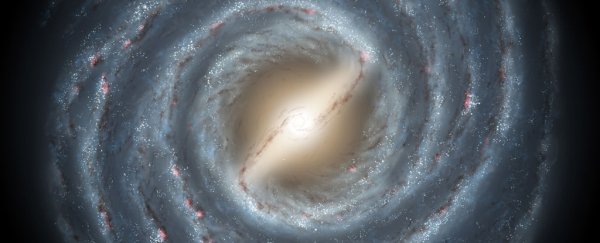Astronomers have discovered that our spiral region of the Milky Way – called the Local Arm – is approximately four times larger than previously estimated.
The discovery suggests that our own cosmic neighbourhood amounts to a more significant portion of the galaxy than we thought, with new estimates indicating that the Local Arm could stretch more than 20,000 light-years long.
While that's still not as big as the four major spiral arms that make up the majority of our galaxy's stars, gas, and dust matter – called the Perseus, Scutum-Centaurus, Sagittarius, and Outer arms – the new measurements are enough to significantly alter our understanding of what our the Milky Way looks like.
"When we actually measured distances in the Local Arm we were surprised," astronomer Mark J. Reid from the Harvard-Smithsonian Centre for Astrophysics told Brian Clark Howard at National Geographic.
"A lot of the material that we thought was in a nearby arm was actually in the Local Arm."
Reid and an international team of astronomers used the National Radio Astronomy Observatory's Very Long Baseline Array of telescopes to measure radio emissions around the Local Arm, to get a sense of where the busiest star-forming regions in the sky were located.
It's not as easy as you might think, because we're located inside the very spiral we're trying to map – and not only are the distances involved truly mind-boggling, but our perspective is obscured by all the cosmic matter that we're trying to pin down.
"The fundamental problem for [observing] the Milky Way is that it's a disk-like system and we're inside the disk," Reid told Eva Botkin-Kowacki at The Christian Science Monitor.
"Let's say you have a disk, and you paint a spiral pattern on the top of it. When you turn the disk sideways and look at it, you can't see that spiral pattern."
But while the Milky Way is difficult to see via optical telescopes – just as it is for amateur sky-gazers, albeit for other sorts of reasons – radio telescopes make the task possible.
"Radio telescopes can 'see' through the galactic plane to massive star-forming regions that trace spiral structure, while optical wavelengths will be hidden by dust," researcher Ye Xu from the Chinese Academy of Sciences told Rebecca Boyle at New Scientist.
By combining new readings for eight regions near the Local Arm with previous measurements, the team finally realised the true extent of our own cosmic cul-de-sac.
Scientists previously thought that the Local Arm was more of a spur-like feature than a spiral arm proper. But the new findings reveal that it's closer in size and rates of star formation to some of the other spiral arms – although some five to six times shorter in length.
But the team did find evidence of a new spur formation in their data, discovering a bridge-like structure that extends between the Local Arm and the neighbouring Sagittarius Arm.
"This lane has received little attention in the past because it does not correspond with any of the major spiral arm features of the inner galaxy," the researchers write in their paper.
It's thanks to these sorts of oddities and asymmetries that the Milky Way probably doesn't look like the perfectly neat swirl we thought it did (such as in the artist's impression pictured above).
"[O]ur galaxy probably does not have one of these beautiful spiral patterns that we see in some external galaxies," astronomer Jo Bovy from the University of Toronto in Canada, who was not part of the study, told The Christian Science Monitor.
The find follows the recent release of a new map of the Milky Way by the European Space Agency, which shows that our galaxy contains more stars than anybody previously realised – over 1.1 billion in total (and counting).
So, even if it might not be as perfectly pretty as we once imagined it to be, the Milky Way still has plenty of surprises in store for us.
The findings are reported in Science Advances.
